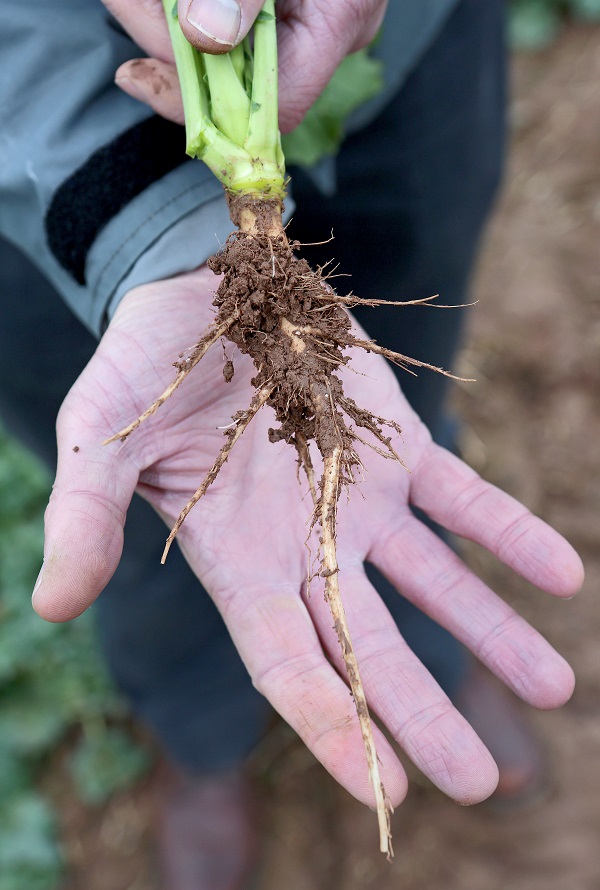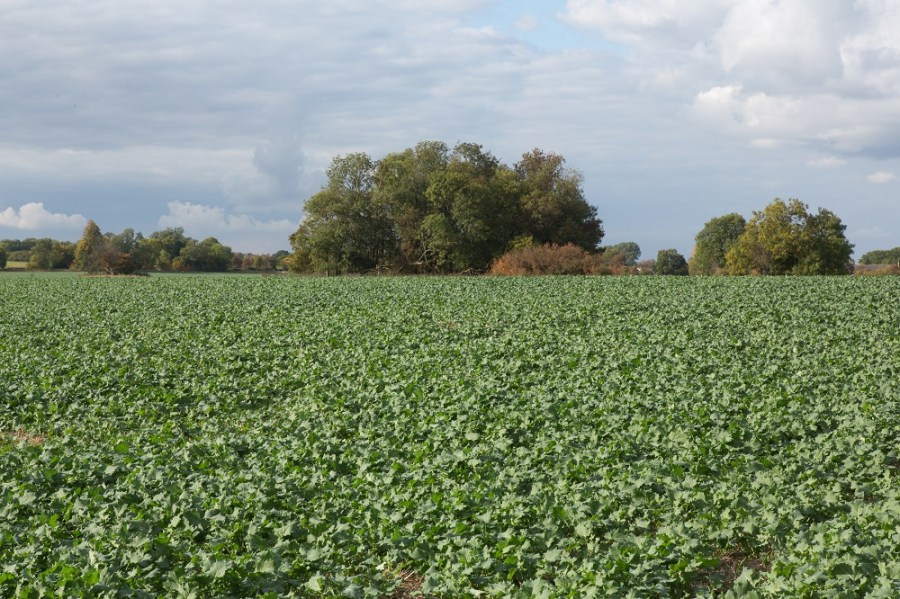Just as oilseed rape is losing the last of its established seed treatments a new option, Integral Pro, will be available this autumn. CPM finds out how the UK’s first biological seed treatment in OSR works and what to expect from it.
BAA acts as an elicitor and triggers the plant to defend itself.
By Lucy de la Pasture
This autumn heralds the arrival of a new era in crop protection with the approval of the first biological seed treatment, registered by BASF for use on winter oilseed rape seed. Integral Pro contains Bacillus amyloliquefaciens (BAA) and will be widely available at a time when the two established fungicide seed treatments are being phased out under the regulatory framework.

Bacillus amyloliquefaciens works in a number of ways to protect plants from disease, one of these is to create a protective biofilm around roots.
BASF’s head of seeds, Adrian Cottey, describes Integral Pro as an interesting product which has arrived at just the right time.
“In the past we were blessed with the neonicotinoid seed treatments which formed the basis of OSR seed treatment for years. More recently, the reliance has been on fungicide seed treatments but thiram, the last registered fungicide seed treatment, is now in its final autumn of use,” he says.
“When thiram has gone, that leaves a situation where there are no currently registered insecticide or fungicide seed treatments for OSR. It’s a time when we’re truly looking down the barrel of the gun for crop establishment,” he adds.
Fortunately Integral Pro has gone through the approval process in time to fill the gap, but Adrian believes the biological will still have a place when other new seed treatments eventually come through the innovation pipeline.
So what exactly can Integral Pro be expected to do? “It’s best described as a biofungicide,” he says. “So it has the potential to replace the seed treatments we’re losing but it also does a little bit more.”
Adrian’s very clear that as a biological, it would be unrealistic to expect 100% control but when compared with thiram seed treatment in trials, it’s been pretty equivalent in all cases.
BAA is a gram-positive bacterium that’s active in the rhizosphere and is commonly found in soil ecosystems worldwide. Its growth begins underneath the outermost cells of primary plant roots at the points where lateral roots grow and then spreads along the root surface.
“This creates a protective physical layer (biofilm) around the root, which is the first mechanism to help stop fungal infection as the BAA outcompetes other seed-borne microbes, such as Phoma sp. and Alternaria sp.,” explains Adrian.
The biological seed treatment also brings with it some natural fungicidal chemistry, namely iturin and surfactin. These are secondary metabolites produced by BAA as part of their own defence mechanism and both are potent antifungal cyclic lipopeptides.
“In petri-dish studies, there’s a visible ‘zone of protection’ formed around the roots in exactly the same way as if you’d used a synthetic fungicide substance,” he explains. “We’ve found BAA has activity on phoma (on the label), alternaria and rhizoctonia but there’s no activity on pythium, which causes damping-off in seedlings.”
The third way that the BAA bacteria in Integral Pro work is an interesting one, highlights Adrian. “BAA acts as an elicitor and triggers the plant to defend itself (plant-induced systemic resistance). With phoma for instance, there’s not just a reduction in the seed-borne phase but an ongoing reduction in stem canker which lasts throughout the season.”
With all three defence mechanisms in play, the biological also adds another layer of protection by stimulating the OSR plant to grow, explains Adrian. “Bacteria have a dynamic relationship with the plant and in experiments carried out by the University of Nottingham, we’ve seen improvements in the top growth and statistically clear increases in the below ground root growth.
“The work at Nottingham also demonstrated a speeding up of emergence. We tested four different hybrids and saw this effect on each one of them, with the biggest effect on the slowest emerging variety when compared with untreated seed. The response was even greater when compared with seed which had been treated with an experimental insecticide, which slowed growth slightly,” he explains.
“That’s good news for growers looking to get crops out of the ground and established quickly and a more robust plant because of its enhanced root and shoot growth. This is why I believe that Integral Pro will have a place even when other conventional seed treatments come along which can be used alongside it,” he adds.
There’s a lot of grower interest in using some treated OSR seed imported from EU Member States where Lumiposa (cyantraniliprole) insecticide seed treatment is already registered and Adrian confirms that Integral Pro can be used alongside it, as well as be coapplied with nutrient-type seed treatments.
The expectation is for Integral Pro to be used on 5-10% of OSR seed in its first season, with BASF aiming to treat most of its InVigor varieties. There’s also been wide interest from other breeders, with Adrian believing most will apply Integral Pro to some seed which means it’ll get a good test.
He also believes that farmers are well placed to get the best out of a biological as this forms the basis of their whole farming system anyway, so they understand the interaction better than most.
“It’s difficult to be black and white about any biological system because there are a host of factors which affect it. All biological systems are variable and it’s difficult to pin down a natural defence mechanism in terms of exactly when you’ll see an effect and what to expect.
“Because the biological forms part of a living system, what we do know is that to work best the BAA need the same conditions required for good plant growth. As long as the crop is growing then the BAA is able to drive the defence against disease,” he comments.
The Integral Pro label also claims a potential reduction against damage caused by cabbage stem flea beetle but Adrian cautions growers not to expect a significant effect under the high pest pressure currently experienced in the UK.
“Where damage from cabbage stem flea beetle is low then you may see an effect but to promise one would be reckless. The data for the label was generated across Europe where flea beetle isn’t such a big problem,” he says.
BAA at a glance
- The first biological Bacillus sp product, Alinit, was marketed in 1897 by a German company which is now Bayer and was found to raise cereal yields by 40%.
- Bacillus amyloliqufaciens (BAA) is a gram-positive, aerobic, endospore-forming bacteria.
- BAA forms biofilms and supports plant growth as well as suppress plant pathogens in the rhizosphere.
- BAA strains synthesise a range of secondary metabolites (not required for the plant’s primary functions of growth, developments and reproduction).
- These secondary metabolites have antimicrobial activity or enhance growth.
- BAA triggers induced systemic resistance in plants, stimulating their own defences to resist infection.
Legalities of Lumiposa
With the loss of neonicotinoid seed treatments the options to protect against flea beetle damage are limited, or non-existent where pyrethroid resistance is a problem.
No seed treatments are licensed in the UK for protection against flea beetle, but Lumiposa (cyantraniliprole), a systemic seed treatment from Corteva Agriscience has been developed to protect OSR seedlings up to the two-leaf stage against cabbage stem flea beetle, cabbage root fly and turnip sawfly.
A spokesperson for Corteva doesn’t expect Lumiposa to receive a UK registration (that permits application to seed in the UK) until at least 2020, but it was first approved in the EU in 2017 and is authorised for application to winter OSR in some EU countries including Poland, Hungary, Romania, Slovakia and Ireland.
That means that even though OSR seed can’t have Lumiposa applied to it within the UK, it is permitted under EU legislation for treated winter OSR seed to be imported from countries which hold an approval and sold within the EU28.
Corteva says Lumiposa ‘isn’t a silver bullet’ but is a valuable addition to the crop protection toolkit for UK growers if it’s used as part of an integrated strategy to manage cabbage stem flea beetle.
Advice from the NFU to growers is that as Corteva have no guardianship of the imported treated seed, any UK growers who purchase imported seed and have enquiries about its performance will need to contact the seed merchant who supplied the seed.
New biostimulant seed treatments
New biostimulant seed treatments JumpStart WT and ProStablish WT from Bayer could help growers increase cereal yields by improving nutrient and water uptake through better rooting, says Claire Matthewman, campaign manager for seed treatments.
“Getting cereal crops off to the best possible start is a key first step in setting yield potential. Single purpose seed treatments, such as Redigo Pro (prothioconazole+ tebuconazole), are an essential protection against damaging soil- and seed-borne diseases, such as loose smut, bunt and leaf stripe.”
But Bayer, through its collaboration with Novozymes, an established leader in agricultural biological solutions, has also been researching ways of helping crops establish a more effective rooting system using biostimulant seed treatments, she explains.
One area of key interest is how to improve phosphate availability. Phosphate becomes bound to cations, such as calcium, iron, manganese or aluminium, in the soil depending on soil pH, while availability to plants also reduces in lower soil temperatures and soil moistures.
“In some situations, up to 90% of phosphate fertiliser can be unavailable to crops in the year it is applied,” says Claire.
The active ingredient in the new product, JumpStart, is the naturally occurring soil fungus Penicillium bilaiae, which produces organic compounds that break the bonds between phosphates and the cations, so phosphate can be taken up by the plant.
“Effectively we are jump-starting the crop by helping to make phosphate more available,” she explains. “But at the same time we also need to address the issue that phosphate doesn’t move in the soil, so roots are only able to take up phosphate in the immediate root zone.”
That’s where the second biostimulant product, ProStablish comes in, which is co-applied with JumpStart and a single purpose seed treatment.
“ProStablish is a messenger or signal compound, which stimulates mycorrhizae fungi to germinate and colonise roots,” explains Claire.
Inside the roots the mycorrhizae form structures that help transfer nutrients, including phosphate, to the plant, while outside of the root they encourage the formation of networks of hyphae that increase the effective root area, allowing plants to take up nutrients from outside the root’s physical range.
“By applying the combination of JumpStart and ProStablish, it makes phosphate more available to be taken up by the roots and easier for the crop to access it, which results in both better nutrient and water uptake and a more effective root system.”
In trials across Europe, results have revealed a 3% yield improvement from ProStablish and JumpStart co-applied with a single purpose seed treatment (SPD), over the SPD alone, she says.
“In the UK we’ve seen similar results in a smaller number of trials and have also observed positive effects on rooting,” adds Claire.
Both products will be available for application this autumn through Frontier. Cost will be at a small premium over the cost of a single purpose seed treatment.




